







 |
 |
 |
 |
 |
 |
 |
 |
Reed is the elite, and the Negative Zone means negativity: the belief that people must do dark, desperate things to survive. That attitude almost killed us all.
This is the story of Reed and Sue. Their first appearance says it all: Reed is in shadow, holding a gun. Sue is in the sunlight, holding a coffee cup.
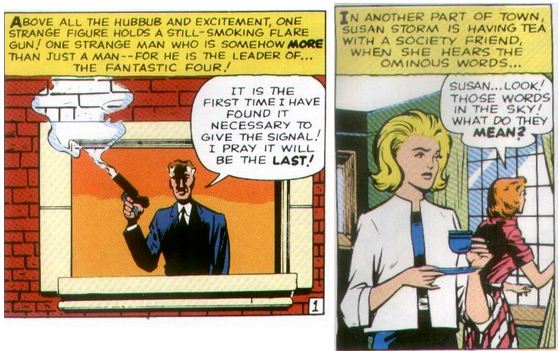
Reed sees the world as a desperate, dangerous place, where a man must do desperate, dangerous things.
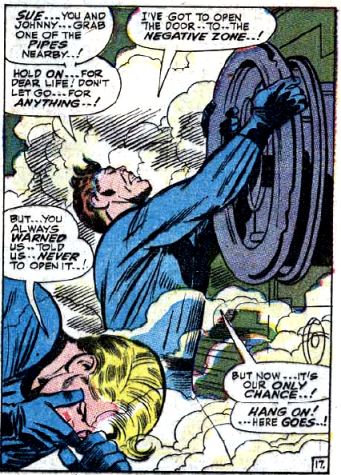
His greatest achievement was opening the Negative Zone, basically a Hell gate.
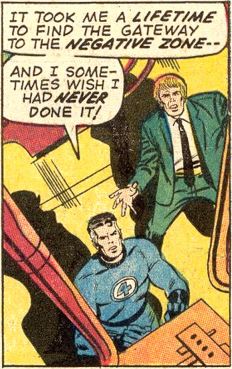
But Sue sees the world differently. Love is more powerful than violence.
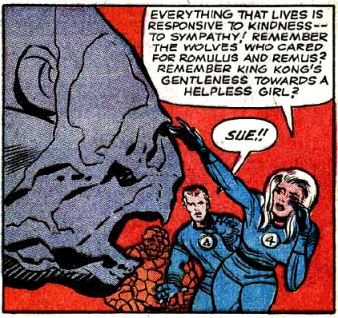
The contrast is embodied in the birth of their son Franklin. To save his family's life, Reed thinks he must enter the Negative Zone. In doing so he helplessly spirals toward death, all in the name of life.
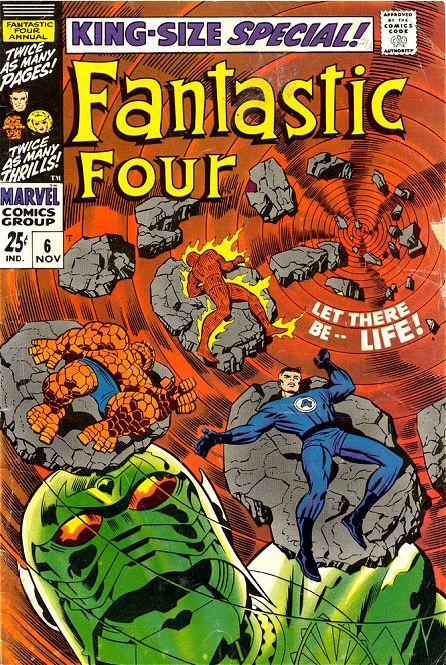
But he could have just asked a friend, Lockjaw, to fetch the item he needed.
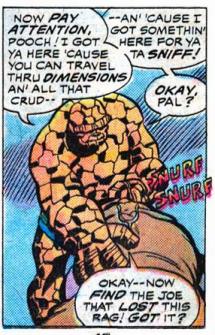
But Reed is always so busy with the next crisis that they never have time to slow down and think of their friends. Their friends could help them, but they are always too busy to build those relationships.
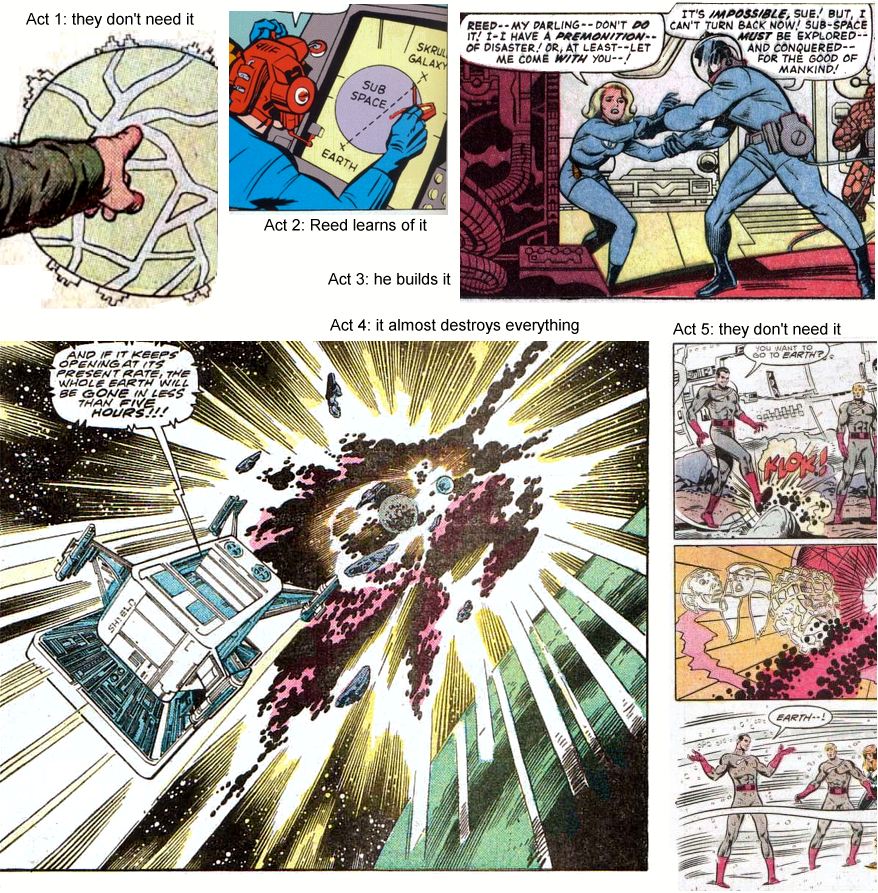
Act 1: the arms race
In issue 1 Reed discovers sub-space portals without realizing it, and attempt to shut down the whole system using violence. It does not work of course. In the rest of act 1 Sue tries to be as violent as the men, and all the great dangers are introduced.
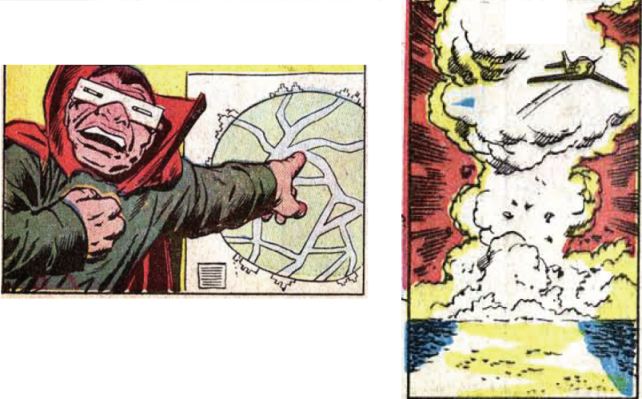
The great dangers in the universe are fleshed out. Negative zone technology is introduced, piece by piece. Sue must decide between the quick easy route (Namor: handsome, powerful, passionate lover) and the slow, difficult route (her promise to Reed, who despite his sexism, need for control and lack of social skills is deep down a humble man who only wants to do good.) Reed's masculine approach leads to the Sue's greatest challenge: the death of her father. She then makes the hardest and bravest choice of all.
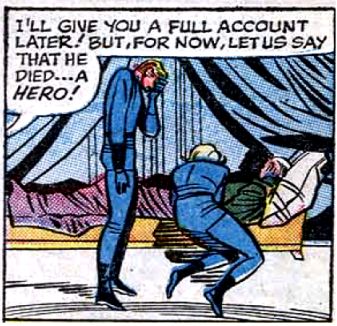
This is the Fantastic Four's golden era: a whirlwind of adventure that feels like a drug-filled high (see issue 76). Excitement builds on excitement: the marriage, the Inhumans, Galactus, the opening of the Negative Zone, the Black Panther, and more. As a good early 1960s wife, Sue does things Reed's way. She takes a back seat and lets him call the shots. But it does not work: the chaos and danger merely increases. But Sue is learning: a love of peace cannot mean silently obeying.
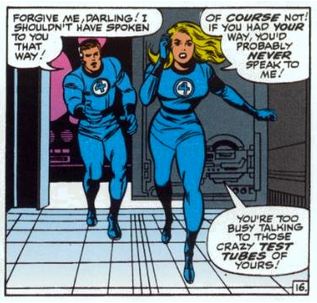
Meanwhile, their son is born. From now on the question of family will crystallize around a simple choice: will Reed choose the negative Zone, or will he focus on Franklin? Franklin (representing family) can solve all their problems, if only Reed could see.
The ever increasing danger has its inevitable end: Reed causes World War Three, everything goes wrong, Reed has a nervous breakdown, but still refuses to put his family first. Faced with this utter collapse Sue has to get away to think. They come within a hair's breadth of divorce. Sue returns to take charge of the team (as the queen in chess: the power behind the throne). This gives Reed a boost of courage, and in an almighty masculine effort he thinks he defeats his greatest enemy. But that way never works, and Reed plunges into denial. He withdraws on himself, pretends everything is fine, tries to kill himself, and eventually succeeds, in a final act of sacrifice that closes the Negative Zone forever.
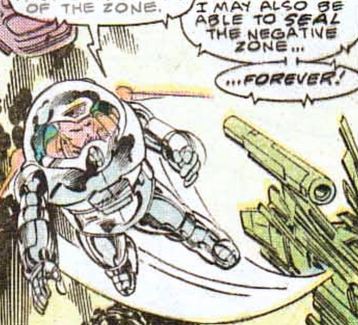
Meanwhile Sue is battling through hell and back (literally), to save the family through love. Alicia, the hyper-Sue, steps in to solve the deepest underlying problems. The team becomes fifty percent female, and through that Reed is brought back from the dead. Thanks to Alicia Ben is now ready to take over Reed's role. Reed is then ready to see another man like himself, and understand that maybe he isn't right all the time. He finally agrees to follow Sue and put Franklin first.
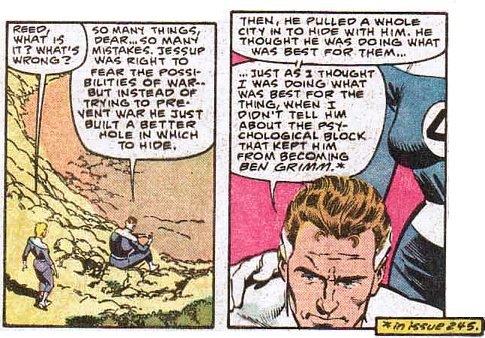
With Reed no longer controlling everything the others can reach their potential. Ben and Johnny are no longer negative: they find love at last, and their power greatly increases. Ben combines strength and empathy and is able to find a better replacement for Reed's technology (the Mole Man already had all that sorted in issue 1). Reed spends time with Franklin, they befriend the Mole Man and the Fortesquans to provide all the technology they need, and everybody is happy. And all cosmic answers are revealed.
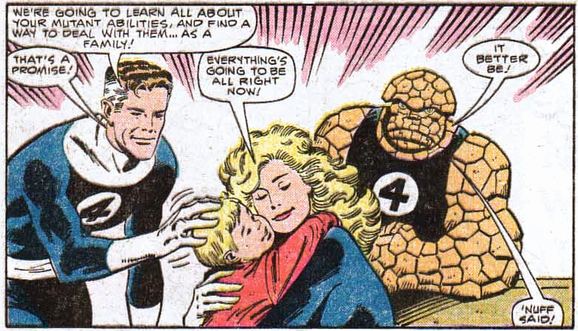
The epilogue
But a woman's work is never done. In the real world there is no
"happy ever after." Franklin has buried years of being afraid, and it
begins to surface in an inferno (FF321-324). Reed misses being in
charge, and decides to come back (F326). Higher beings step in to
prevent the impending disaster (the being who claims to be Aron). We are
then offered several possible endings.
To be continued... in real life.
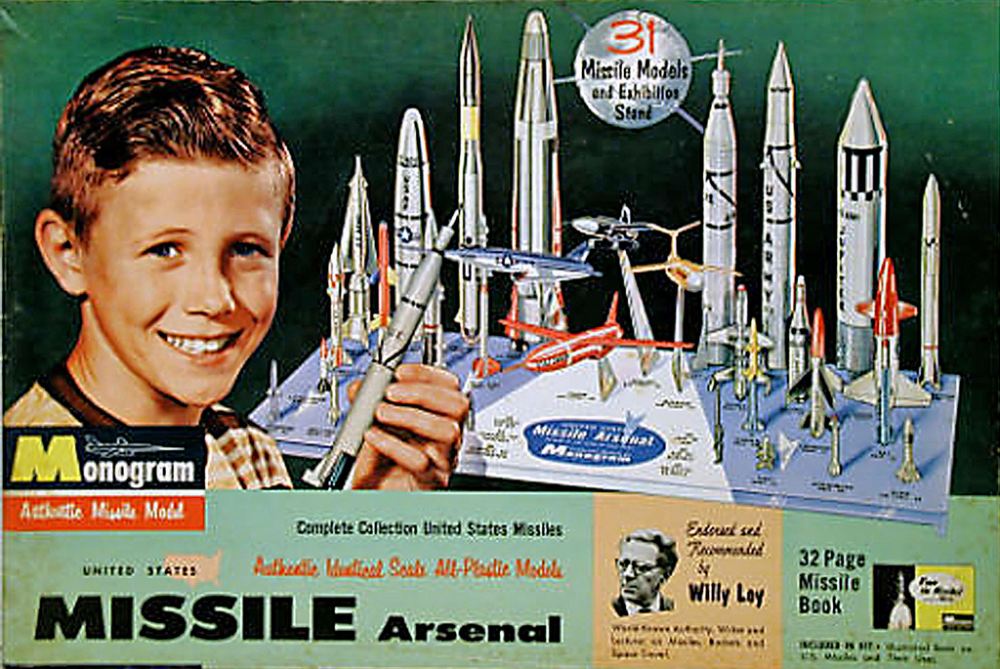

The boys cannot understand the risk. Sue can. She sees the bigger picture.
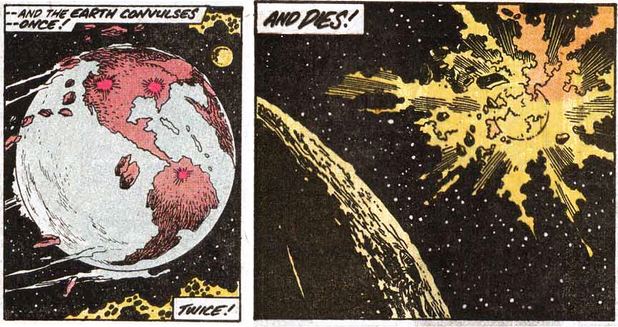
And Sue knows it does not have to be this way.
The Lord of the Rings is about how simple good hearted folk can save the world, but the well meaning wizards can only destroy.
"Tolkien had spent the afternoon walking around Rotterdam--a city that had suffered much destruction during World War II. The sight of it had saddened him, reminding him of the "orc-ery" that he so lamented taking hold of the world. The "cold-hearted wizards," in their quest for knowledge and power, were only good at destroying things. In his final salute to the assembly of hobbit-lovers, Tolkien said that Sauron is gone, but the descendants of the hateful, Shire-polluting wizard Saruman are everywhere. The hobbits of the world have no magic weapons to fight them. But, he adds with a robust and hopeful declaration: 'And yet here gentle hobbits may I conclude by giving you this toast. To the hobbits! And may they outlast all the wizards!'" (source)
Sue is like a hobbit. She has coffee instead of ale, but otherwise
their values are her values. She does not have answers, she is not a
leader, but she has friends, and instinctively knows what is right.
Reed is like a wizard. He is extremely clever and thinks he can control nature but instead risks destroying it.
Acts 1 and 2 of the Fantastic Four are like the book "The Hobbit", a simple, optimistic tale of adventure that ends in a great discovery: the one ring to rule them all (like the Negative Zone). Acts 3 and 4 are like "The Lord of the Rings", an increasingly dark journey to the heart of darkness where the ring must ultimately be destroyed. Act 5 is the aftermath, the age of men (Ben Grimm is the common man) when the wizards and ring bearers go away and a new story begins.
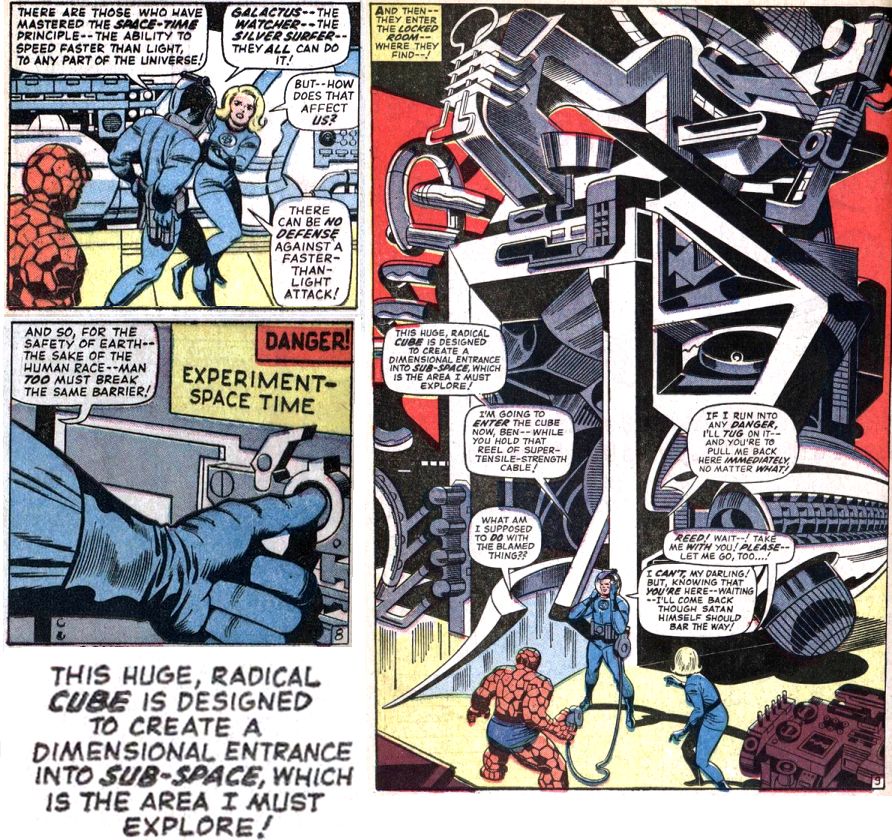

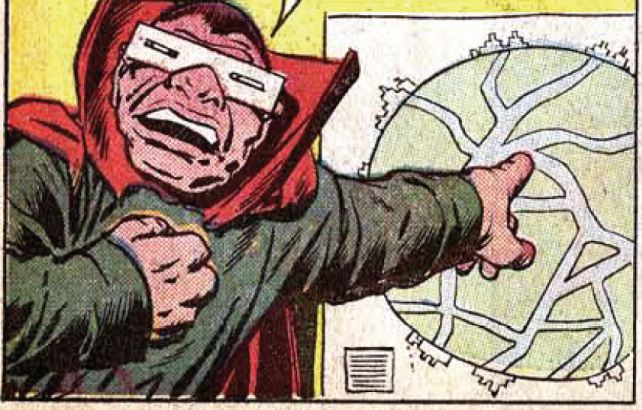
Each tunnel must be thousands of miles long. How could the attacks be
coordinated? And presumably the Mole Man could travel
there at faster than walking pace, but how? There must be high
technology involved. Why was nobody
curious? We begin to see his fabulously advanced equipment in when he
next appears, but still nobody cares: he is just an enemy to be
defeated.
They could have solved all their problems in issue 1
It is not until years later that the team realize he is just a sad, lonely man,
and all he ever wanted was a friend, even though that is the first
thing he told them! When Reed left the team Ben was able to be his
friend, and had access to his best technology: space warps that make
Reed's crude subspace portal unnecessary.
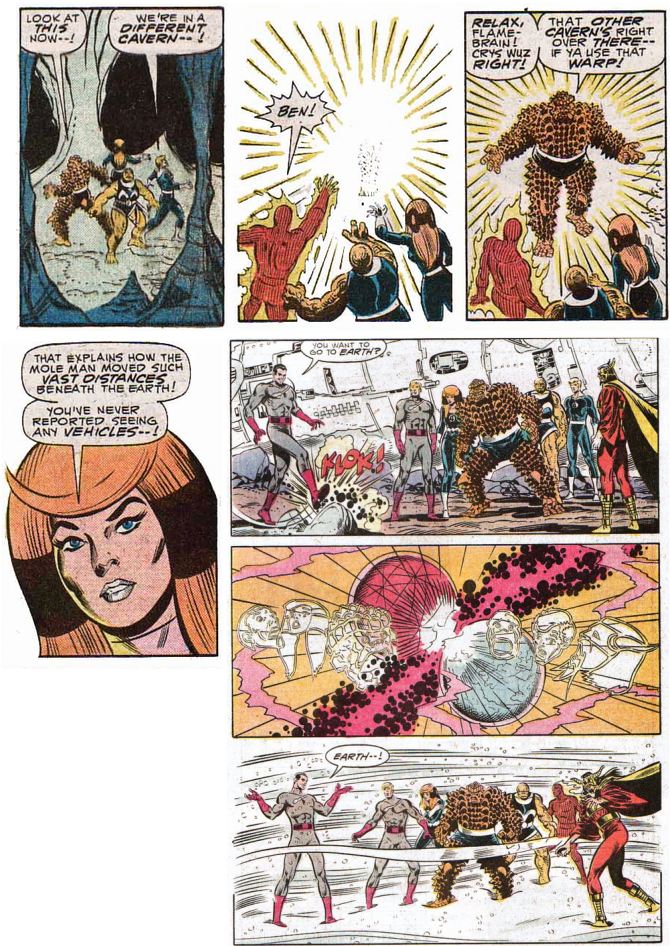
This sets the scene for every story that follows: enemies are only enemies because the team don't take the time to understand them,
Issues 2-3: they continue to miss seeing the bigger picture
Issue 2 introduces faster than light travel: without it the Skrulls
could never have arrived from another galaxy. This left Reed with his
first space ship to cannibalize (actually his second, as we will later
learn, see FF 271). This would form the basis for his later discoveries:
see the page on Reed's technology for details.
reed's great mistake here is to treat the enemy as inferior. He
believes at the end that Skrulls are stupid, easily tricked, and easily
hypnotized. But in fact the opposite is true: see the notes to FF2 for details.
In short, if Reed had tried to understand how the Skrulls thought,
instead of focusing on a technical fix, he would not have been deceived.
This leads to a whole issue (issue 3) based on illusion, where Reed is
busy cannibalizing Skrull technology and does not realize he is being duped.
Issue 4: Sue begins to learn
Issue 4 introduces us to a third group with high technology: The
Atlanteans. Until now, Sue has just gone along with Reed's method: we
must beat the Russians! We must beat the Mole Man! We must beat the
Miracle Man! But now Sue begins to see the other person;s point of view.
(It later becomes clear that
this change of heart is prompted by her own secret history: she is
reminded that you should never judge by appearances. But Reed learns the
opposite lesson: the last frame shows a deadly serious Reed making a
vow to be ready for
anything. "If he dares return he'll find us waiting! I swear
it!"
Issue 5: the first dimensional travel
FF5: dimensional travel
FF5 introduces Dr Doom, a man obsessed with reaching other dimensions (to find his dead mother).
To do this he needs help, hence his appeal to demons. Even Doom
realizes the value of making alliances, and the power of family.
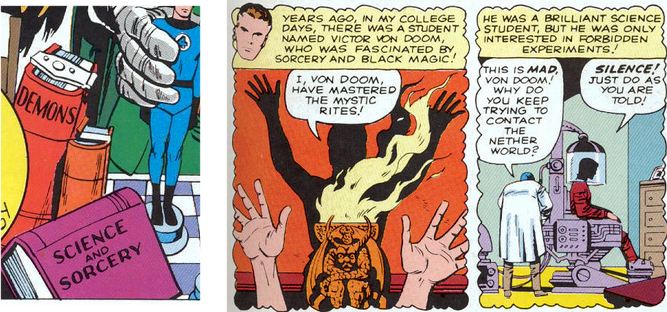
The origin of the
time machine is discussed in the notes to FF 271.
It's key parts can probably be traced to the faster than light drives
on the first ship that Reed ever captured. he time platform gives us the
first clue to how dimensional travel
works: a flat surface moves so that the three dimensional
person is read as a two dimensional plane.
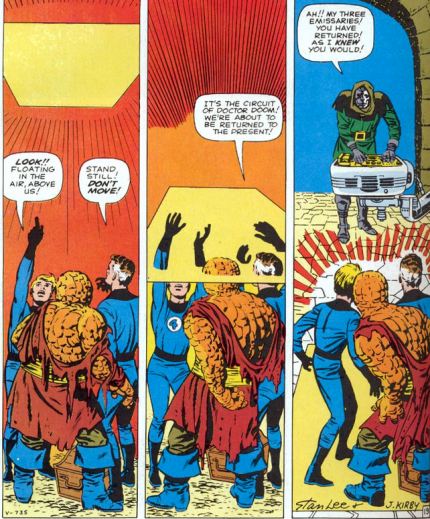
Act 1 summary
So act 1 introduces everything we need to know about sub space portals:
In addition, we have been introduced to the four main kinds of technology:
The portal appears to rely on three technologies:
Let's look at how Reed developed the capability
Act 2 shows the discovery of the parts that will later form the
sub-space portal we see in FF 51. To keep things short I will only
mention these briefly.
FF6: first power ray
In FF6 the arms race
escalates. In FF1, Reed could only reach the edge of space. In FF6, his
great rival Doom shows he can go much further, taking an entire building
into the sun if needed. We also see the two greatest threats combine:
Doom (symbolizing old Europe) and Namor (symbolizing oceanic power
- note Namor's oriental
features). The grabber holds vast power, is able to hold a structure
together (it does not merely make a hole when it pushes too hard) and
travels under a "magnetic beam". This is the first hint of the power ray
from
FF 18.
FF7: Reed obtains a dimensional unit, and learns more about space-time
FF7 is a huge breakthrough: Reed obtains a working saucer from a world
that specializes in anti-gravity. (The previous faster than light unit,
from Gormuu, was probably already scavenged by his father and Doom for
their time machines.) It appears that the planet X saucer is immediately
taken apart: it is seen in Reed's workshop in FF11, as it is not
available for general use until Reed is shown (in FF 92) combining it
with the (not faster than light) Skrull craft from FF 2.
Note that planet X specialized in anti-gravity. Gravity is just curves in space time, so controlling gravity and compressing people to ve very tiny (a shrinking gas) would be closely related. These insights would prove invaluable later.
FF8: more planet X technology
Applying Occam's razor, the puppet master probably used planet X mind
control technology. See the notes to FF8 for why. The more technology
that Reed sees, the better he can understand how it all fits together.
This technology appears to be in the form of clay: probably
nano-technology gray goo.
FF9: "no more mister nice guy"
Reed's financial problems humiliated him. For a mind like Reed's, this
would lead him to be even more independent, to always be "strong"
(meaning rich, controlling and not taking advice).
FF10: the shrinking ray: key to dimensional travel
FF7 gave Reed to some alien shrinking technology (essential for
understanding space time on a quantum scale) and now Doom has it too.
it's an arms race! Sue will understand that Doom was only defeated
because they understood Reed as a friend. But Reed will see this as proof
that he needs more and more technology!
FF11: extreme unstable molecules
The Impossible Man embodies unstable molecules taken to their greatest
extreme. A few issue later we will see Reed creating a similar form of
unstable-molecule life, and then the Mad thinker improving upon it to
create a slower less intelligent version of the Impossible Man
FF12: "project 34, the anti-grav missile"
The anti-gravity missile probably indicates that Reed has been sharing
his Planet X technology with the military, thus becoming their friends
at last. Access to military scientists will increase his progress.
Anti-gravity is of course the key to creating wormholes. The barrier may
be a very crude and weaker version of the matter-antimatter negative
zone shell used by Maximus and Annihilus.
FF13: an unlimited energy source
What could release so much energy from a
single metal bar? Probably stable pockets of antimatter within the
meteor. It appears that Reed was unable to duplicate this, but it would
have planted the idea in his mind.
FF14: biotechnology
The "roving eye" technology appears to be left with Sue, so Reed can
study it. This is able to broadcast through miles of water, so may have
very exotic technology. The bigger the variety of technology Reed has,
the more he can understand how it all works.
FF annual 1: Reed experiments with matter transmission
Reed's device to isolate the sea water and make it evaporate is a device
to remove mass from A to B: a first very crude dimensional ray, a first
step to the full size sub-space portal.
FF15: biotechnology and unstable molecules
Reed's device in annual 1 could only transmit a simple molecule, and
could not keep to together. To eventually transmit living flesh and keep
it one one place means Reed has to study biology. No doubt inspired by
the Impossible Man, Reed is trying to understand organic molecules by
seeing how unstable molecules can imitate life.
FF16-19: the big breakthroughs
Now that Reed has returned triumphant from the moon, and met the
Watcher, he is ready to discover take the first steps in human scale
dimensional travel:
FF16: breakthrough 1: dimensional travel via shrinking
In FF 7 Reed worked wit shrinking technology but was against the clock
and could not bring any back with him, Now he has more time and the
people are friendly; he can gain a much better idea of space time at a
quantum level.
FF17: experimenting with the new technology
FF18: breakthrough 2: the sub-space matter ray
FF19: Reed takes control of the time machine
This is probably something Reed should have done long ago, but he was
not in a position to use it. Now he understand more he can
disassemble it and make his own (using planet X parts as needed)
FF20: a Cosmic Cube Fragment
This is our first clear glimpse of the power that gave the team
their abilities: a fragment of a cosmic cube. See FF 319 for details.
FF21: dimensional shifting
The hate ray appears to be based on planet X "hostility ray", as was the
Puppet Master's clay. In all three cases, mind control is linked to
anti-gravity technology. Reed seems to expect this. Why?
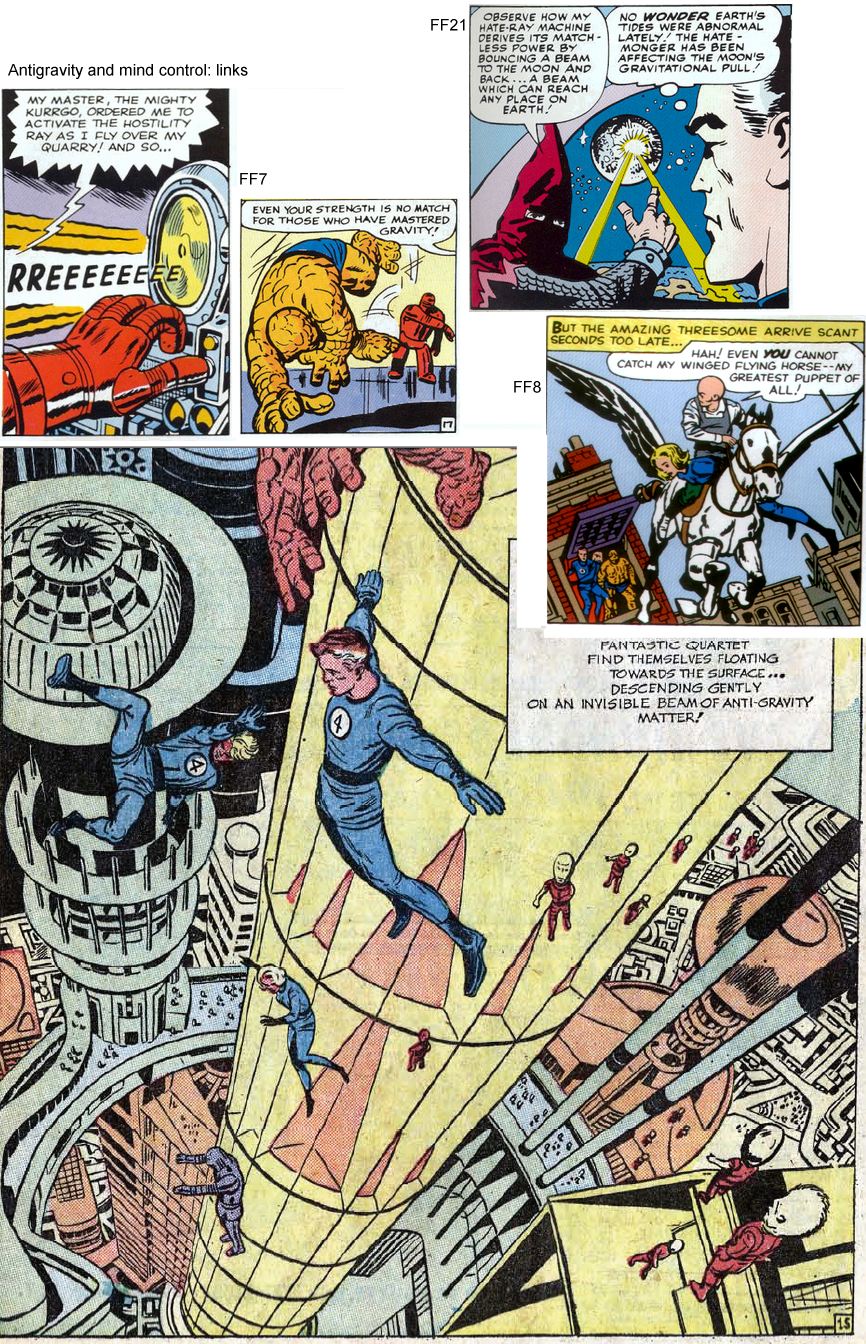
From now on, Reed
will focus on putting the basic discoveries together and seeing what they
can do. With the discovery of the Molecule Man he has all the puzzle pieces that will be finally brought together in FF319
FF22: forcefields imply dimensional shifting
Reed's increasing understanding shows him that Sue's ability to divert
light should also let her divert force. This suggests dimensional
shifting again: Sue is shifting light from A to C without passing
through B. Light is a vibration of forces (electrical and magnetic) so
why can't she do the same with force in general? So a person who hits
her never transmits the force to her body? Later in the Franklinverse,
Tom DeFalco's will take this further and argue that Sue's dimensional
shifting even lets her break through a Celestial's unbreakable skin (see
FF400).
FF23: Doom makes progress with dimensional travel
Once again we see the arms race: Doom (by incorporating magic) is ahead
of Reed in dimensional shifting he can shift people or entire rooms.
FF24: Reed's first sub-space experiment; first thought helmet
This is the first use of what will become the thought projector helmet:
This first version is probably just a simple device to help him focus on
these extremely difficult calculations. But gradually he will add more
connections to detect brain signals. Gradually the device will be
improved, reading more and more data about the brain. Dimensional travel
is extremely reliant on the mental state and requires a lot of
computation, hence Lockjaw's very large brain and the large heads needed
by dragons (see FF annual 16).
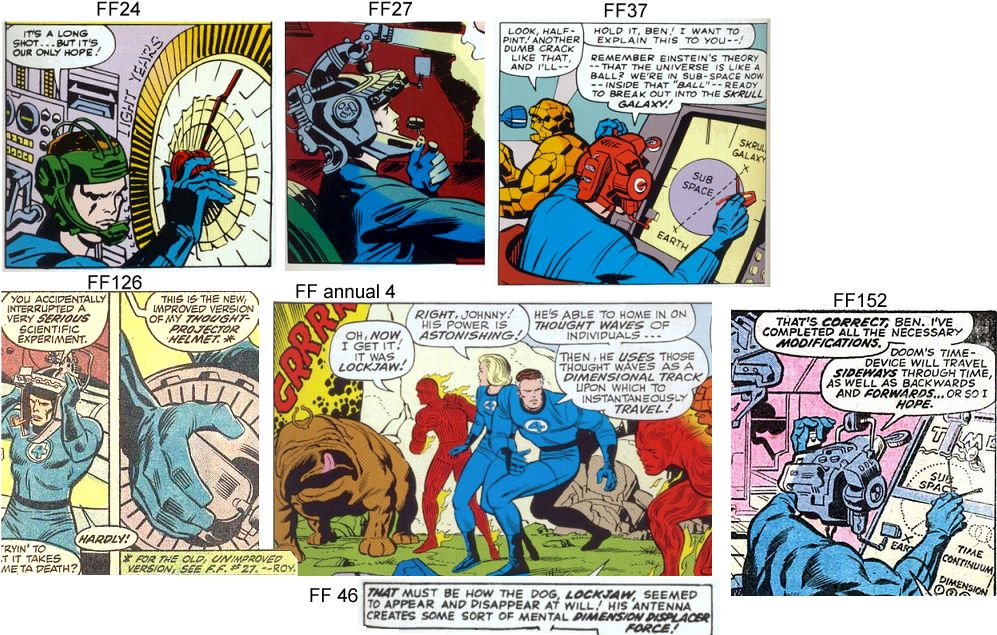
FF25: an unstable molecule virus
Reeds better understanding of minds and dimension shifting leads him to
try designing a virus for Ben. His previous biological experiments were
with unstable molecules, and since this involves mass sifting it must be
the same.
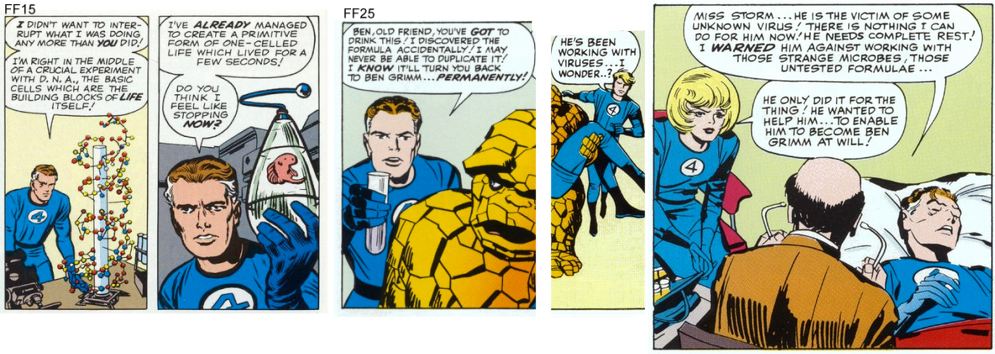
FF26: the gamma ray capsule
Reed and Bruce Banner met in FF11 where Reed was sharing technology.
Bruce has a capsule that provides gamma radiation to trigger a change.
Clearly Bruce understands gamma radiation and mass shifting. It is unclear whether he has shared that knowledge with Reed.
FF27: improving the helmet
FF24's mind helmet now has thought projection abilities. Reed says it is
for crime fighting, but the team are not crime fighters. In FF51 we see
that all his sub-space research is kept secret from the others.
FF28: further study on mind control
At the end of the issue Reed correctly guesses how a mind controller
could turn off the Awesome Android, and he is impressed by the fine
control of just a part of the Android's "brain". This agrees with the
previous conclusion that Reed knows about crude dimensional shifts but
is now thinking more about the details of the brain.
FF annual 2: dimensional travel focuses on the mind
Doom's origin story sheds more light on his obsession with dimensional
travel, and the complexity required. Note that his machine focuses on
the head: keeping thoughts intact when shifting to a parallel reality is
the hard part.
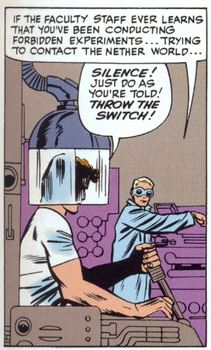
FF29 the Watcher tells him what he needs to know
At exactly the time when Reed is struggling to put his ideas together,
the Watcher steps in. he says that Reed's brain is not big enough to
handle the technology, so he arranges for Reed's brain to expand. He
then shows how gravity hold star systems together, then explains matter
transmitters and power rays. This is everything Reed needs to know!

FF30 exploring "magic"
Reed knows that Doom uses magic to win the arms race. So Reed arranges
holiday and "accidentally" lands by a low level magician. Reed is doing
everything he can to understand.
FF31 further improvements to the brainwave scanner
The new version allows thoughts to be broadcast We can see a clear
progression here. The early research was to dimension shifting in
general, and the later research is based on the keeping the mind intact.
Also in this issue we see the huge extent of the Mole Man's technology.
But once again it doesn't occur to Reed that the Mole Man just wants a
friend, and could be persuaded to share his amazing hoard. Instead, Reed
reinvents the wheel in the most dangerous way possible.
FF32 the power ray as subspace transit
Now Reed sees how a power ray can also transmit people and objects. He
also learns that once created, a power ray link cannot be easily shut
down, and he has built a device for using it to cause damage (he cannot
yet do anything more useful). This is no doubt inspired by what he
learned in FF29.
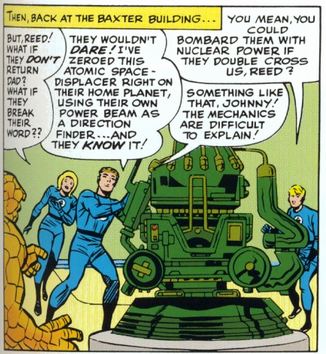
FF33 pulling matter from other dimensions
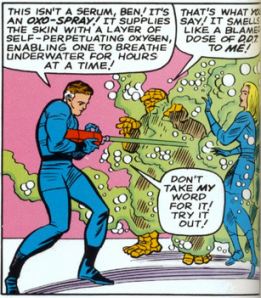
FF34: time tech spreads
Reed has teams of men and other scientists helping him, giving
us a glimpse into how he achieves so much. Obviously this risks losing
some secrets: Gideon manages to obtain a crude version of the time
machine, at
great expense. It is very crude, it simply throws them to unspecified
time in past.
It possibly uses the dimensional unit from Doom's castle or Reed's own
machine
FF35: Reed can study a permanent connection between dimensions.
It cannot be a coincidence that Reed visits the place where
artificial life is being studied. But Reed must pretend it is
coincidence, as his work is secret (see FF 51), How is the Dragon Man
animated? Magic is simply highly advanced
technology, and the simplest way to make a thing live is to
connect it to a spirit from another dimension. This is advanced
dimensional communication. For more about demons and
robots see the notes to FF23 (the Thing robot) and FF143 (on Doom,
robots, and Darkoth).
FF36: anti-gravity
Reed gets hold of three anti-grav disks to study: understanding how
to manipulate localized gravity is the key to understanding wormholes.
The Wizard apparently obtained the Skrulls' anti-gravity pack and
flaming suit (see super technology page for details) and worked out how
to use them
FF37: first journey in subspace
Here Reed is able to use the Skrull power beam to take an entire NASA
space craft to the Skrull galaxy, showing that he now understands it
well.
FF38: studying Skrull power plants
The splash page shows Reed studying Skrull power plants: a dimensional portal needs vast quantities of power.
FF39: Reed uses anti-gravity
This issue shows us the state of the art for Reed's knowledge:
The flaming suit - this is almost certainly the one recovered from the Skrulls, and temporarily captured by the Wizard in Strange Tales.
The Robot - probably adapted from one in Doom's castle.
Extending arms - based on robot tech
The forcefield: this builds on his experience in FF22. With the captured anti-gravity disks he can create his own crude version that simply pushes things away from Sue.
Invisibility: this is based on "vibrating" - 1960s code for dimensions (see the DC superhero The Flash, who shifts dimensions by vibrating). So this is the real breakthrough technology: the first attempt at dimensional shifting a human body. Note the similarity with the barely visible people in FF271, again from a parallel dimension via the time machine. This is not as advanced as a general purpose sub-space machine: moving partially to the closest possible dimension, just enough to not be seen, is very different from a complete shift to a totally different world.
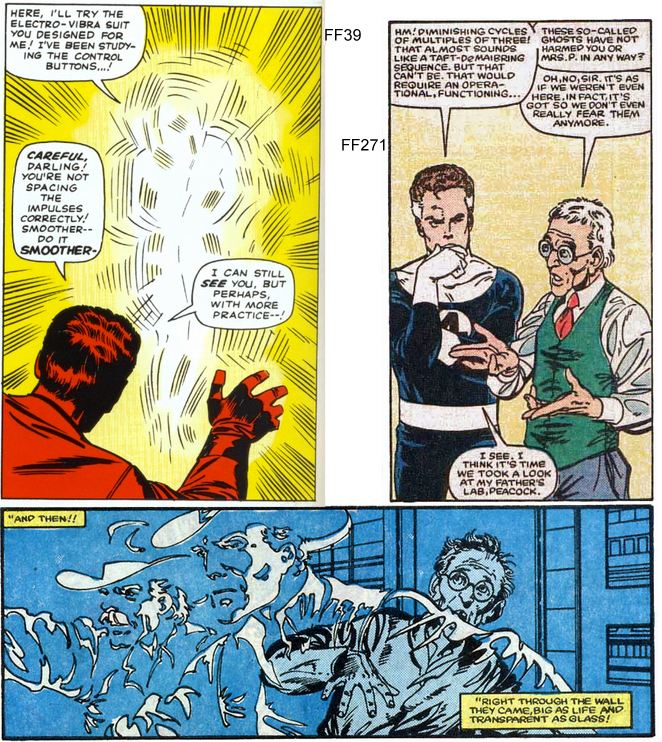
Also in this issue we see an air displace vortex beam: a variation on the water displacer in annual 1, and seen later in FF 198.
FF40: energy needs, and the arms race
The stimulator apparently recharges unstable molecules, so it is like a
miniature sub-space portal: it changes every particle of the body, and
shifts mass as needed so the person becomes an alternate version of
themselves. Here we see that such a device requires vast quantities of
energy: Reed has a nuclear device yet it
still took days to recharge. Presumably the energy is needed to create a
dimensional rift for every particle of the body. In this issue we also
see the state of Doom's armor. He has:
FF41 and FF43: the state of the art: mind reading
This issue shows the current state of mind detecting. By FF296
Reed will have a global brainwave scanner, but at this early stage he
resorts to listening to police broadcasts and knocking on doors.
Meanwhile the Wizard has a mind control device that appears to require
some kind of surgery. Undoing the effects in FF43 requires some very
complex equipment, thousands of volts of energy, and deadly radiation.
At the same time (FF 43) Dr Doom has a targeted version of the hate ray
from FF21, and in the following issue (annual 3) SHIELD has general
purpose sloes range mind reading technology. All of this is evidence of a
mind-reading arms race. Everyone is working hard to improve the
previous versions, and they must be getting help because the secrets are
leaking out to everyone else. As noted, scanning a mind is essential to
the sub-pace portal.
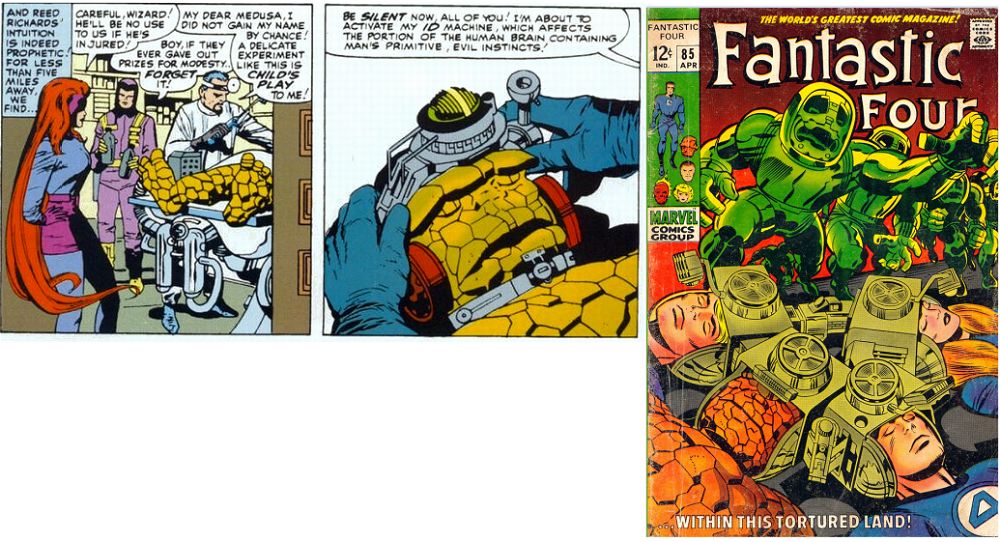
FF42: Reed gains the Wizard's tech
Reed finds the wizard's storehouse: he becomes familiar with the
technology and no doubt studies it when the Wizard is in jail. This is
standard practice: Reed studies the Wizard;s technology, Doom studied
Reed's when he was in the Baxter Building, Reed studied Doom's when he
copied the time machine, the Wizard studied the Skrull torch suit, Reed
shares ideas with the military in order to get their support, and so
on.Plus from time to time they all capture alien devices, and so the
knowledge and technology expands at a rapid pace.
FF annual 3: the Watcher's tech
Here the Watcher again gives Reed the freedom to quickly examine
his sub-space technology. Reed then chooses a variation on a sub-space
portal. he isn't allowed to keep it, but just choosing and operating it
will give him vital insights.
FF44: first contact with Inhuman society
Inhuman technology is 25,000 years ahead of ours, as noted in FF annual
20. With friends like these he finally has access to any remaining
missing parts.
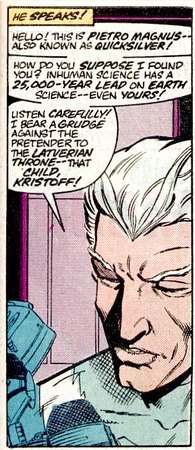
In FF51 Reed finishes his secret project, a working sub-space portal at last!
| No more issue reviews I hope it's clear by now that every single issue of the Fantastic Four adds to the technology, and builds naturally on what went before. My original notes go into detail for about a hundred more issues, but I just don't have time to edit them, because every edit always turns into a re-write and more original research. The point is that the Fantastic Four grows organically, and the technology does make sense (on its own terms). There is endless detail: a person could easily devote a lifetime to studying it and barely even begin. So from now on I'll just cover some highlights. |
The sub-space portal is protected by heavy doors, partly in case
anything unwanted comes out, but probably also because of the enormous
energies involved. The heart of the sub-space portal is a pair of
electrodes. The person has to jump between or near them.

The best guide to the portal and the control room is in FF107-110. Examine the pictures closely and you get a pretty good idea of how it's all laid out. Note that the distortion zone though very thin, feels much wider because time itself is distorted.
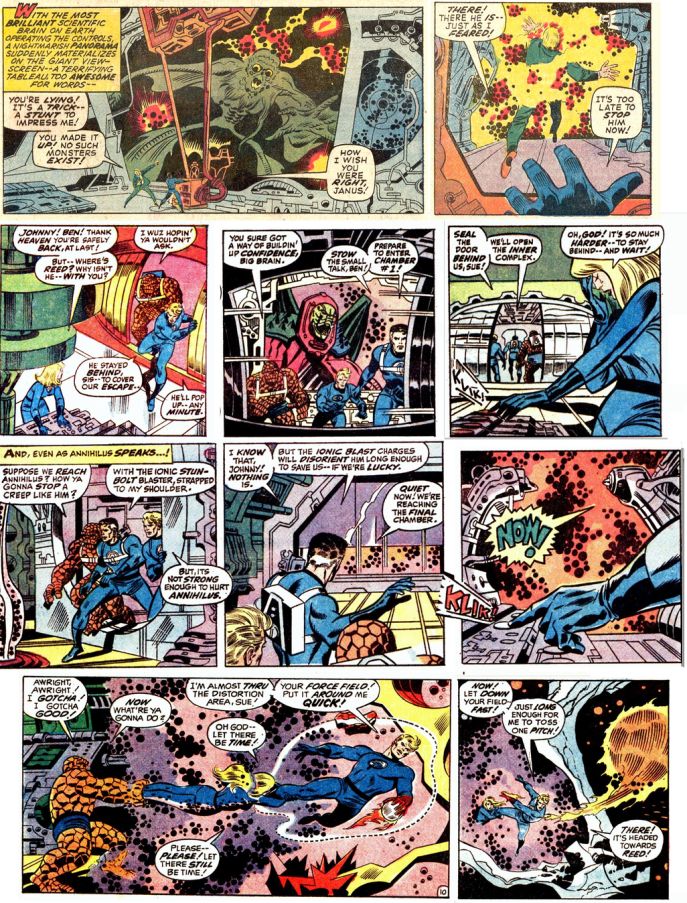
The system requires enormous amounts of energy:
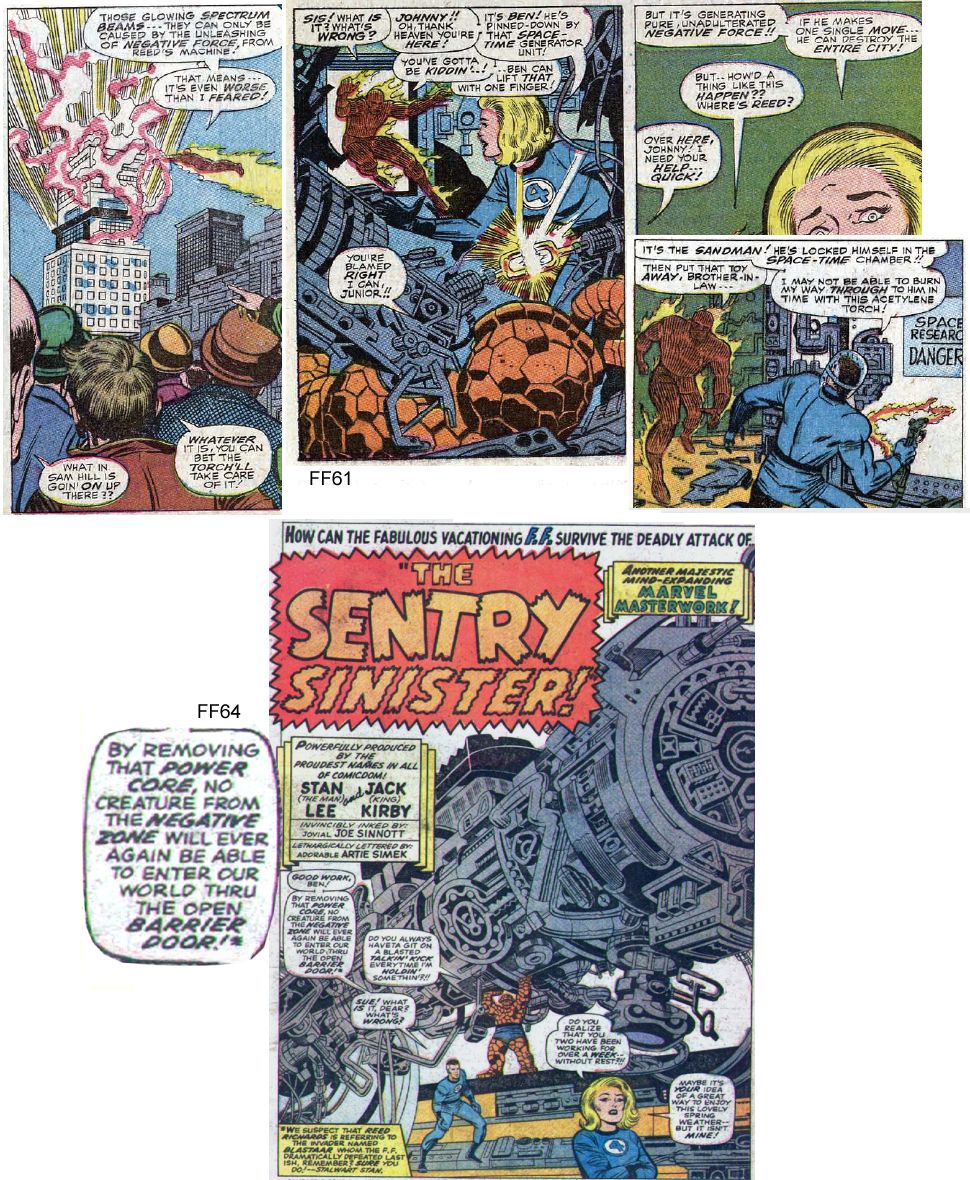
Reed calls his device a "radical cube". In mathematics, "radical" refers to going back to dimensional origins (e.g. square roots, cube roots, etc). In theoretical physics, all reality is the extension of equations from an initially much simpler set of conditions at the Big Bang. In chemistry, a radical is a reactive particle: e.g. a free radical is an unpaired (and therefore highly reactive) electron. If Reed's radical cube works by reducing a person to the primal root state, then this state is potentially anything, and is therefore highly reactive, a kind of free radical. So presumably Reed's radical cube works as follows:
The experience of being in a quantum timeless state is experienced as the distortion zone.
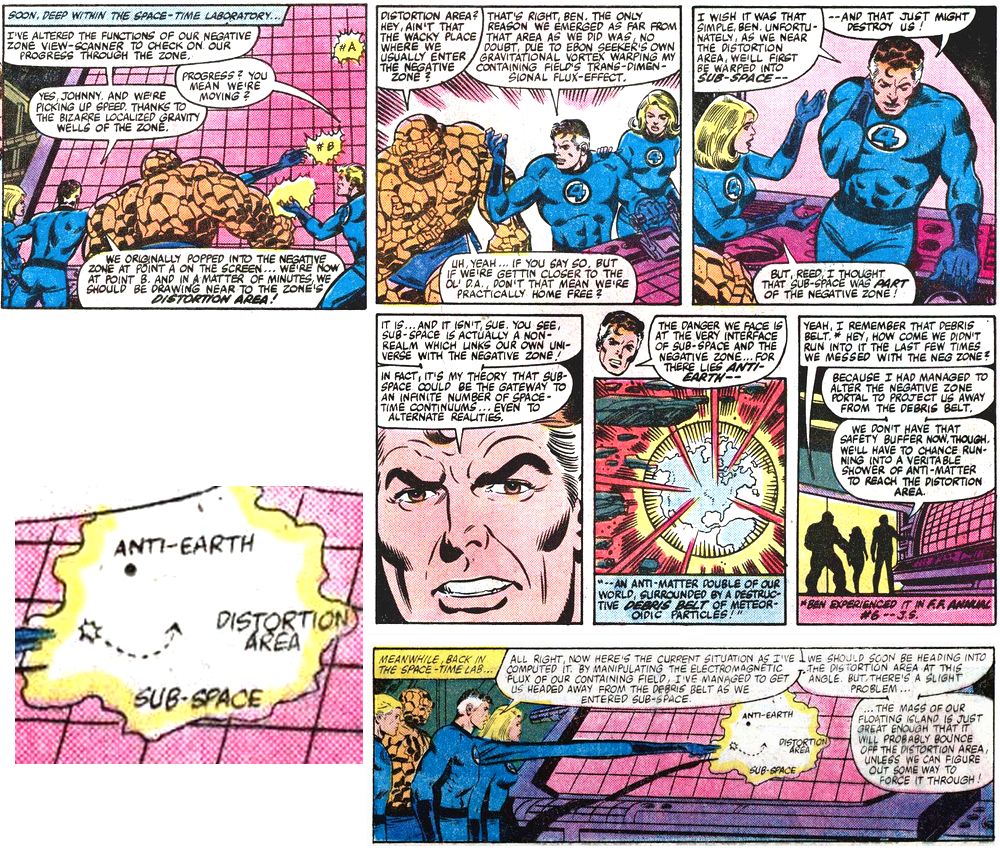
Here are some of the stranger aspects of the portal, and possible explanations.
"What about..."
The negative earth?
Dimensional travel is based on probabilities. A random traveler is more
likely to end up near an alternate earth than away from it. Reed said
that he expected to see a parallel earth nearby.
Positive and negative matter in the debris belt?
This is near the nexus of realities, where dimensions overlap. Hence we
expect a mix of strange left-over material, both positive and negative.
The debris is attracted to the earth?
The matter and antimatter explosions creates both negative and positive
energy. This creates a mix of attraction and repulsion. The result is a
swirling chaos that (in this case) has a net attractive force: the
so-called nega-force.
Breathable air between the planets?
This is probably only near the nexus: Negative Zone space craft do not
show the streamlining that would be needed of air was everywhere. The
air is probably the result of the nexus of realities: an infinite number
of parallel planet earths are connected, and there is an attractive
force pulling on them all. It probably strips a little air from the
upper atmosphere of all those worlds.
Humanoid beings?
Subspace is the link between alternate realities. Probabilities mean the
realities we access will be relatively close to our own.
The cosmic control rod
General purpose super power is always dimensional in nature. This in
turn is affected by probabilities. So the cosmic control rod will
naturally be close to the nexus of realities. This also explains why
Annihilus spends so much time min this area despite ruling a much larger
domain.
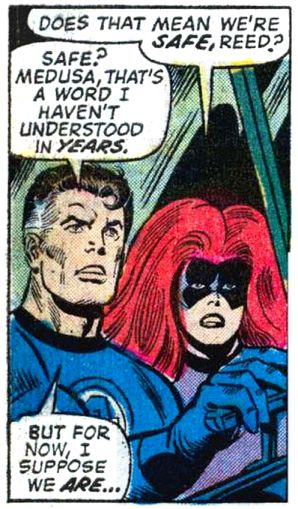
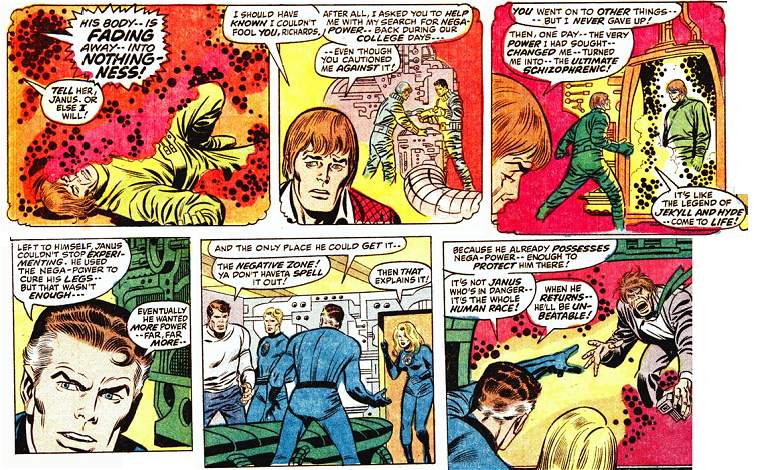
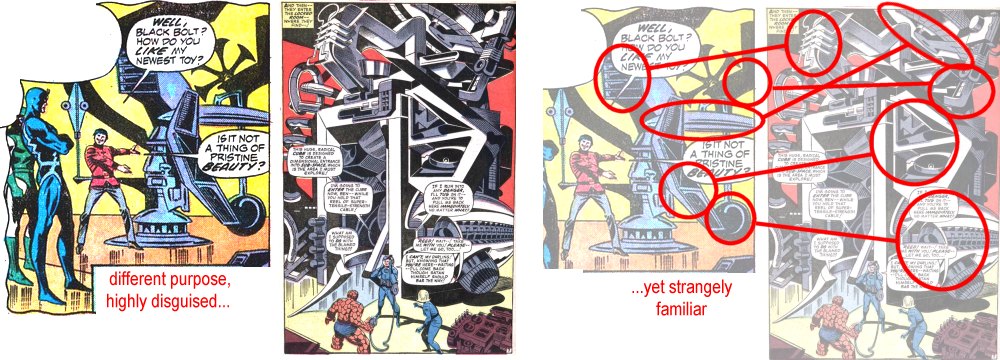
FF176-184: the Negative Zone epic
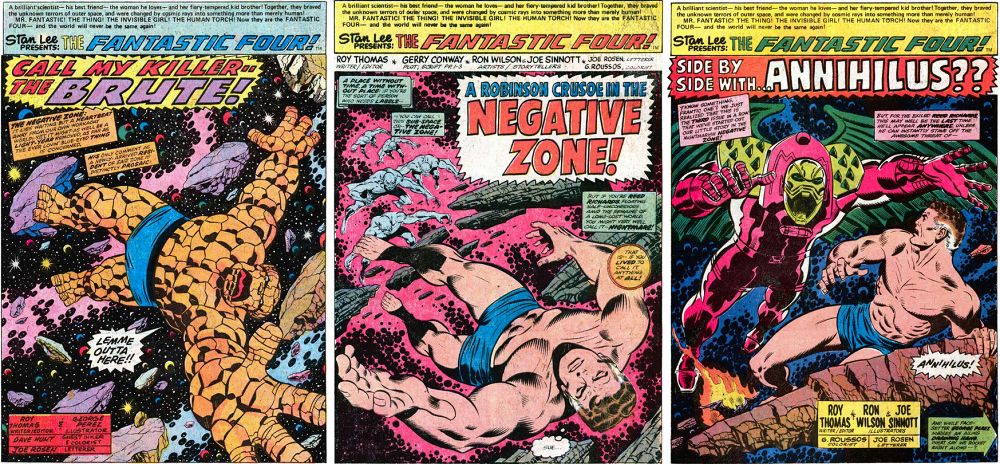
This is the longest Negative Zone sequence in the entire 333 issue epic. It comes just after the half way point, and
reflects the centrality of the Negative Zone to the 28 year story. Note
that the story revolves around the symbolism of the Negative Zone:
Reed's emotional isolation leading to emotional weakness, reflected in
his physical limitations.
FF178: more about the cosmic control rod
By
comparing Tyannan technology to that of the High Evolutionary we see
they deal with the same thing: the same goals, concepts, tools,
costumes, etc (with minor variations). So it is probably the same life
tubes, the source of the control rod. We get more insight into the
High Evolutionary's origin and the nature of his technology.
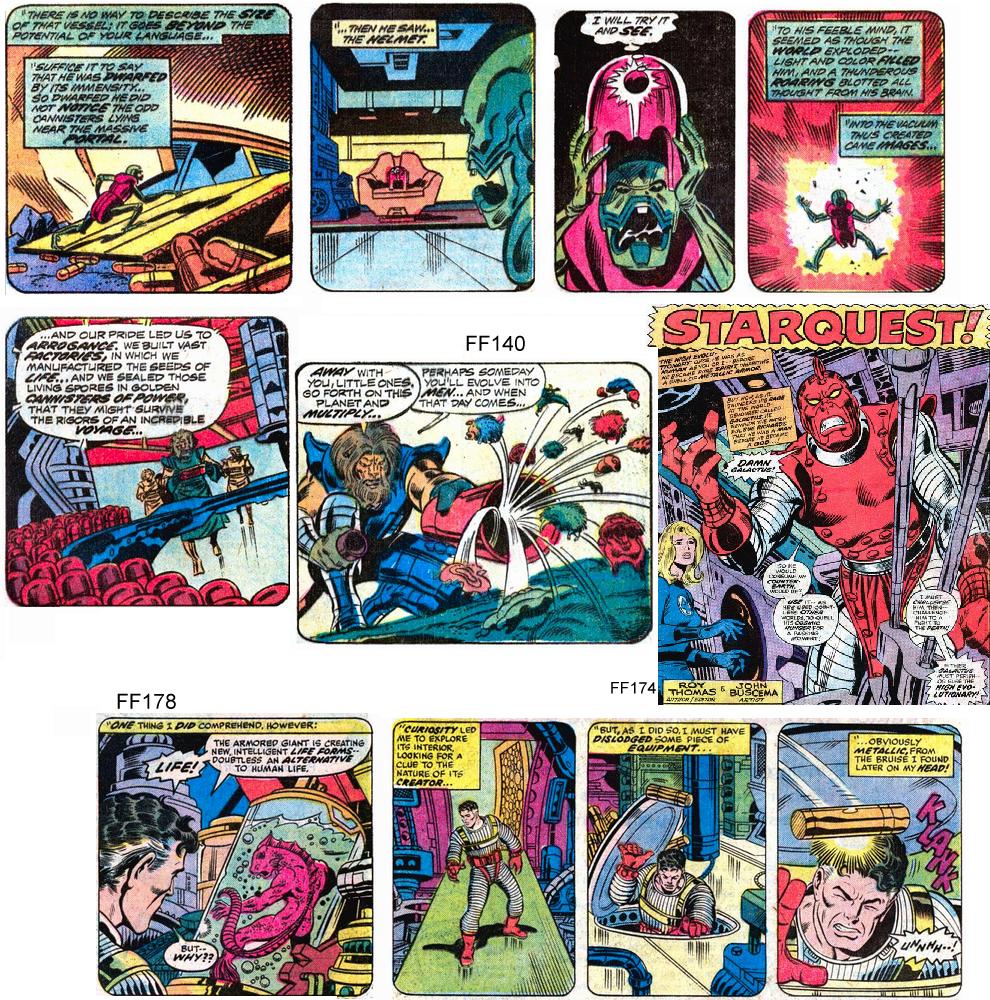
Note that counter-Reed only assumed he was physically hit by the control rod, rather than a
concussive blast, and that it as an accident. Someone as advanced as
the High Evolutionary would not let people simply wander into his
ship: it must have been deliberate. Note that the name and nature of the
Brute suggests evolution. And note the central role of self-directed evolution in cosmic cubes in FF319.
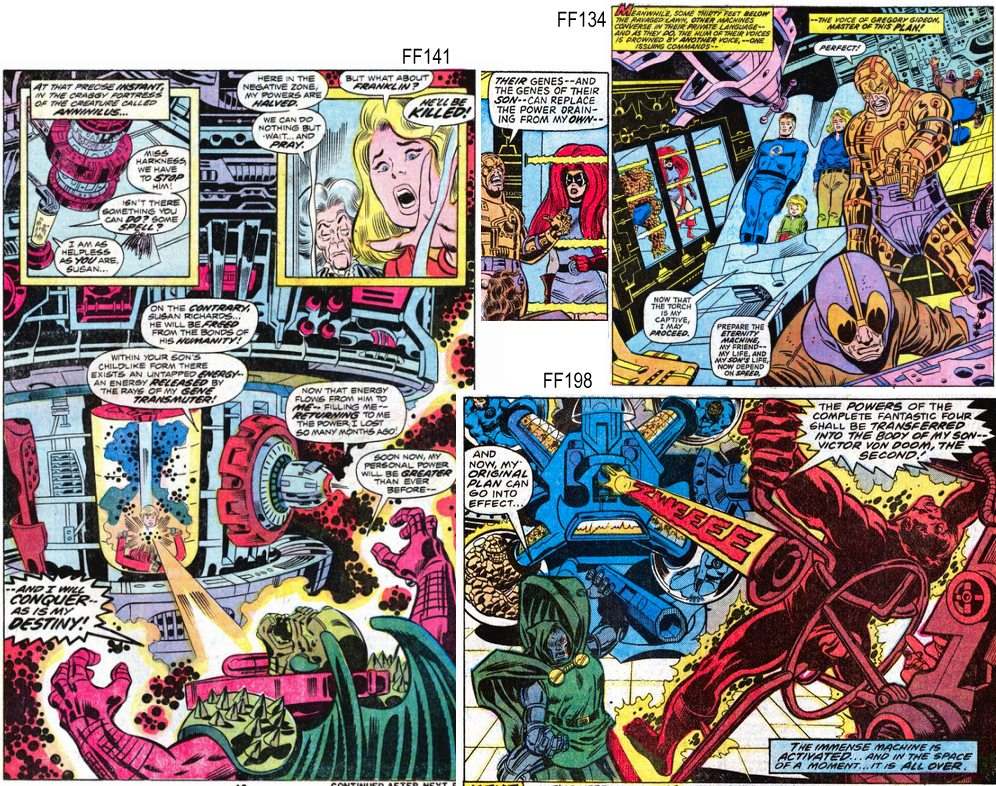
FF297: the extra-dimensional siphon
This drains
the sun's energy: it could be bigger than any dimensional portal yet
seen; bigger even than the space fleet sized hole in FF292. Note the
progress in portal sizes:
This would force Reed to reconsider his own decision to close the
portal. But note the death of the scientist,. showing once again that
personal relationships are more powerful than technology.
FF303: Thundra's dimension
This is all about travel between parallel dimensions. Note the familiar motifs:
FF annuals 20 and 23:
Reed and Franklin's shields: another topic to study if you're
really into this stuff. And another example of where relationships are
more important than technology. Putting Franklin first would have solved
it, and no amount of technological shielding can.
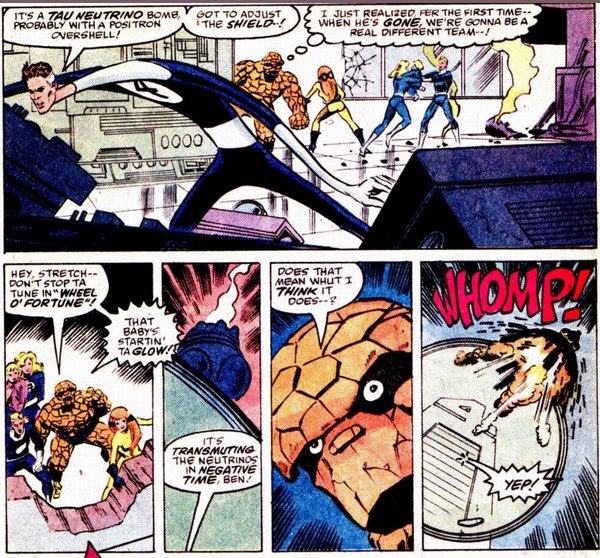
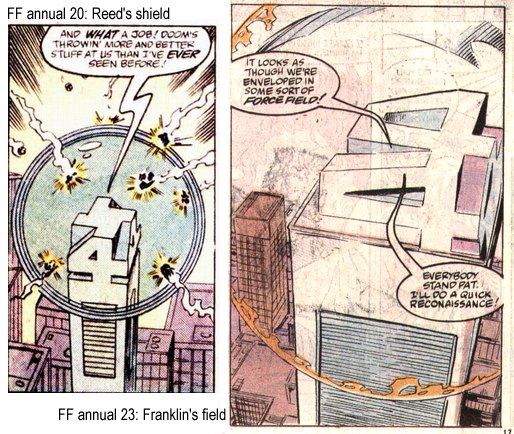
FF307: the Franklinverse
Regarding the Negative Zone, we see that Franklin can navigate the distortion zone safely
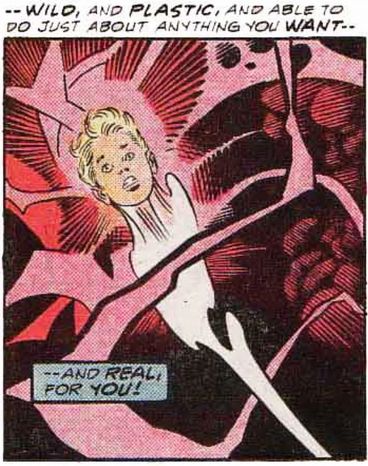
We see that Diablo's power goes far beyond simple chemistry: he is swapping dimensions.
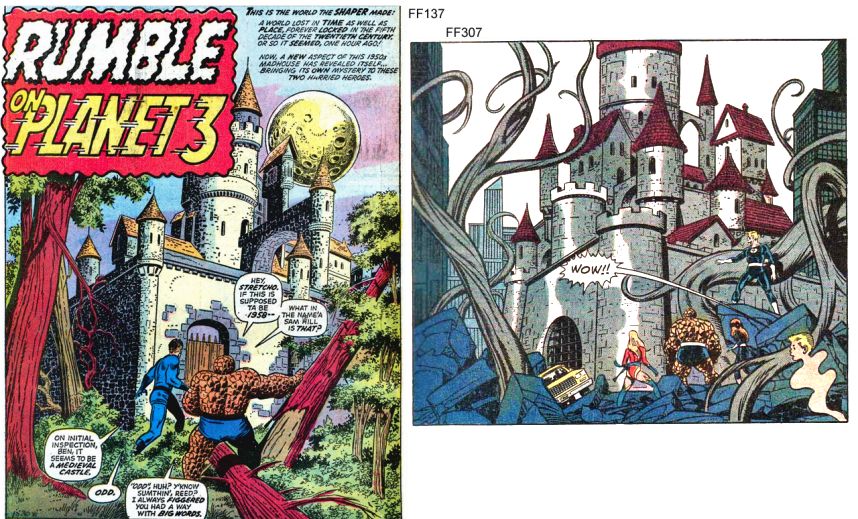
We foreshadow the moment when continuity ends and we enter the Franklinverse, never to escape
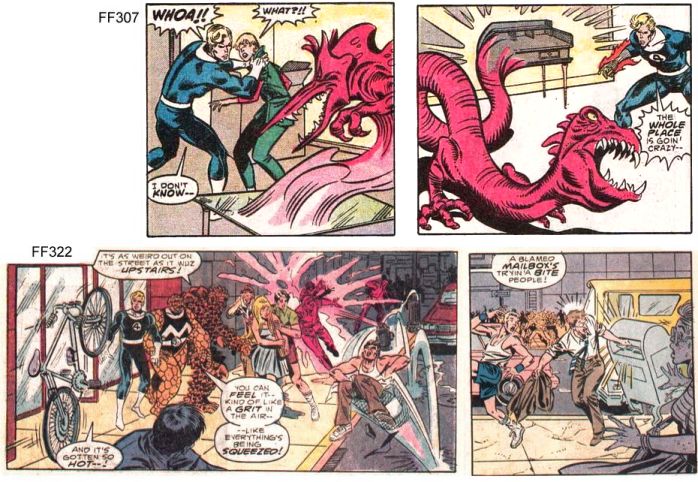
All these events are covered in depth in the main issue reviews. but they have to at least be mentioned here.
FF51: The Man This Monster: generally considered the greatest issue ever. The Negative Zone is opened.
FF139-141: Annihilus escapes and almost kills Franklin
FF222: Nicholas Scratch escapes via the Negative Zone
FF230-1 the team reach their lowest point
FF251: the Negative Zone "holiday"
FF290: the successful suicide: closed forever
FF319: everything is explained:
They finally enter
crossroads of infinity, something that's been tantalizing us since FF51,
and fulfills Reed's ambitions to explore ever farther, from FF1
So negativity is not the answer. Understanding is.
Understanding does not mean "being nice" to really evil guys. It means understanding their needs and fears. Understanding enables you to do business even with enemies. And half of the time you find the enemies are willing to be friends, which is even better. Understanding is always the key. Investing in weaponry only makes things worse. Take the Skrulls and Kree for example: nobody can pretend they will ever be friends, but they have self interest, and some of them are smart. So they do finally come to an agreement simply to survive.
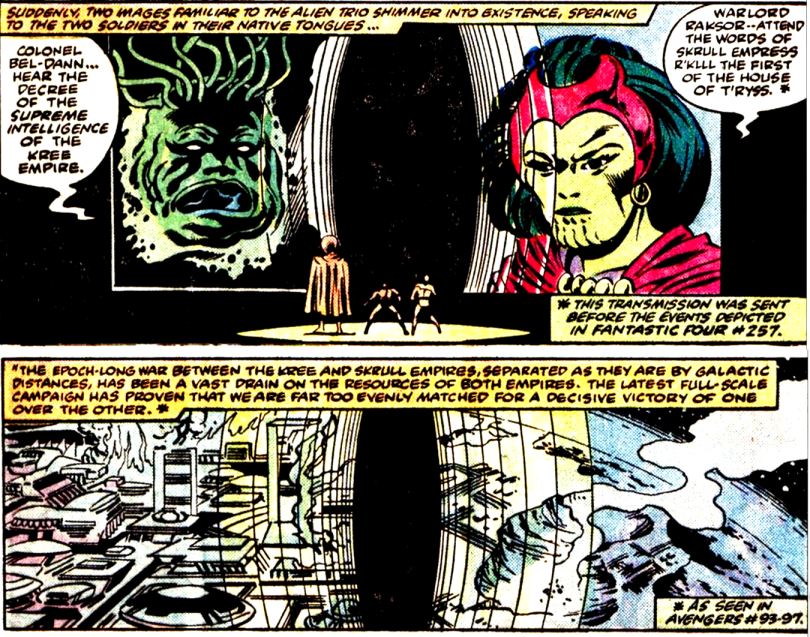
Skrulls have differences like any group, and some Skrulls can be reasoned with. Sue's method works.
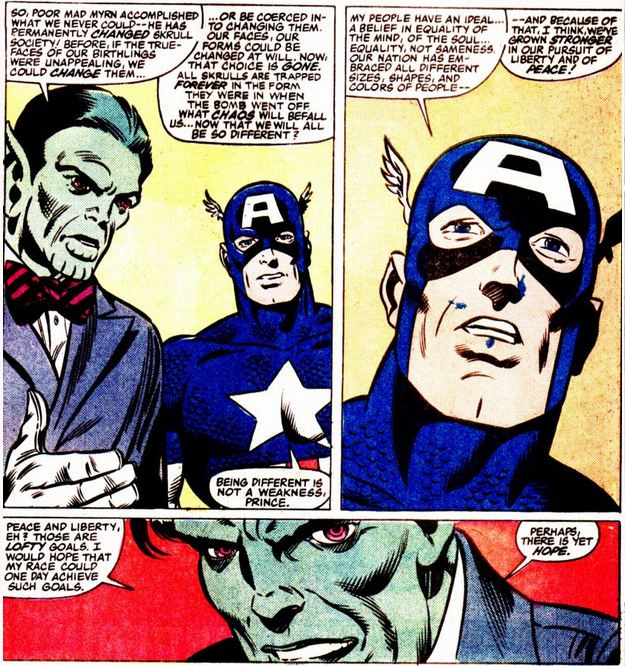
So in the final analysis, Captain America is right. We don't need to
compromise our values. We don't need to go negative. if Galactus, the
ultimate killer, can do something, that doesn't mean that we should too.
Values make us stronger.
The Fantastic Four is a positive, inspiring book, and that's why I love it.
